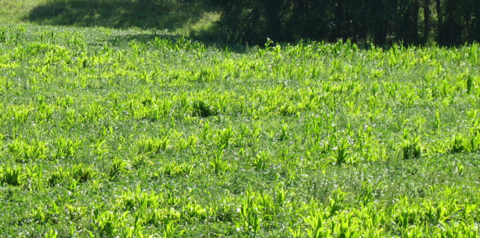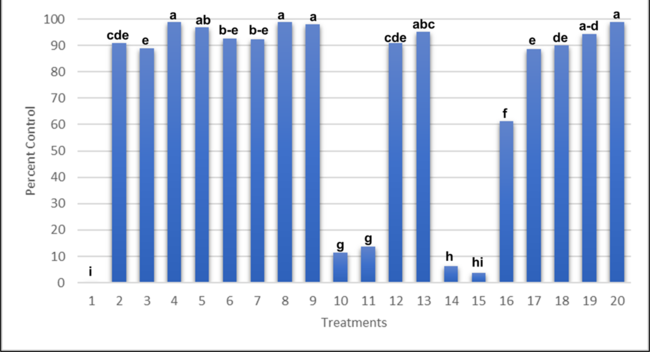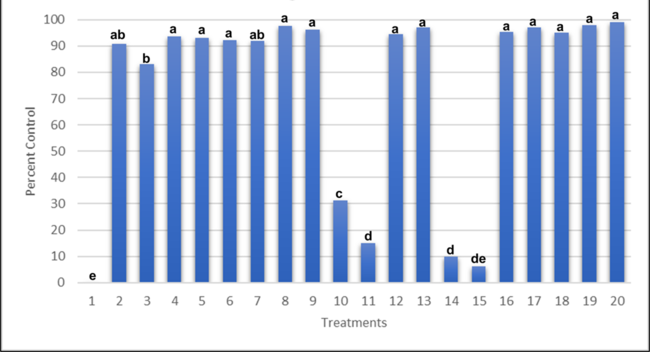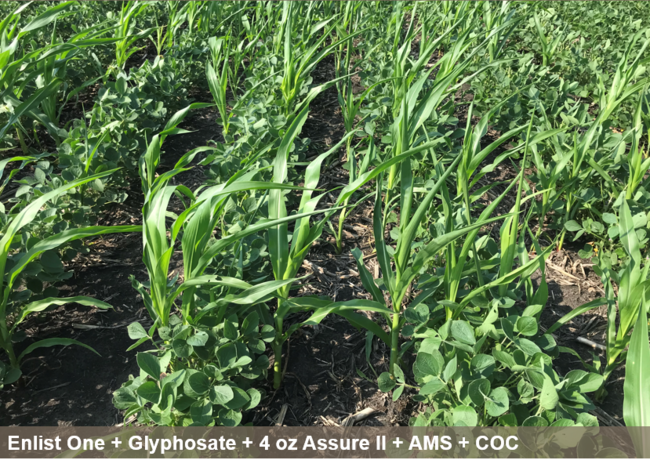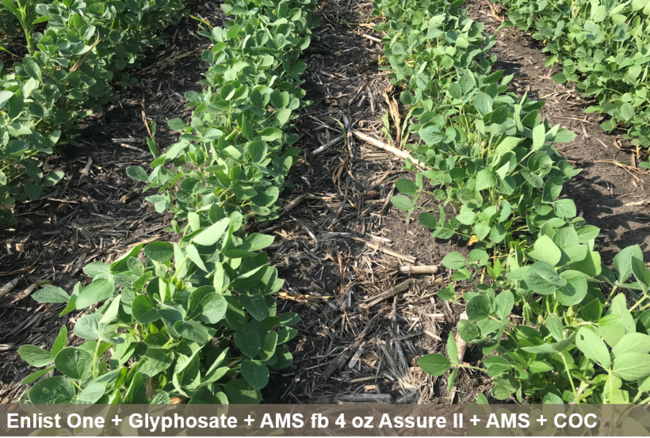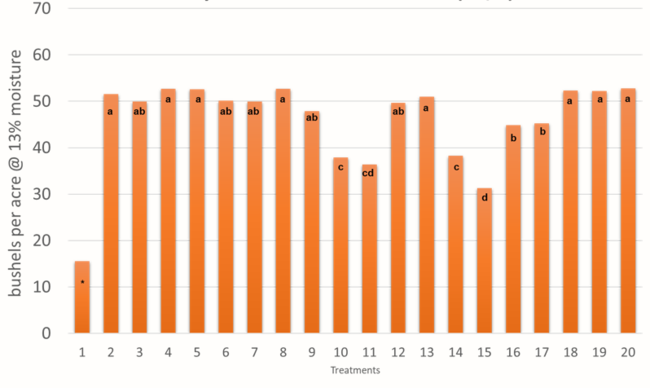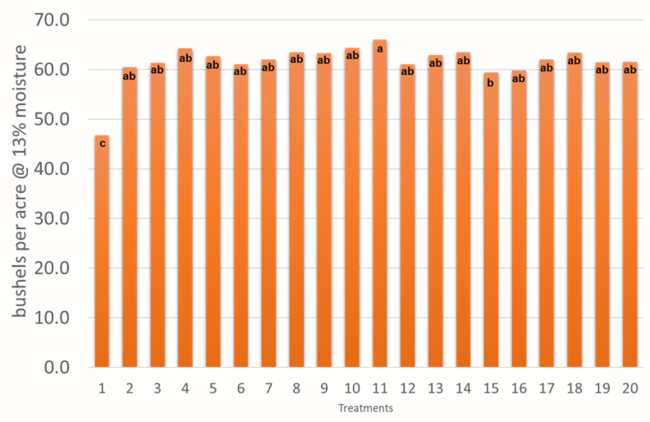- Soybean varieties tolerant to Enlist, glyphosate and glufosinate have been widely adopted by Minnesota soybean growers.
- Growers and ag professionals have reported difficulties controlling volunteer corn in these systems.
- ACCase-inhibitor herbicides show antagonism when tank mixed with auxinic herbicides, resulting in reduced control of grassy weeds and volunteer corn.
Soybean varieties tolerant to the herbicides Enlist, glyphosate, and glufosinate have been widely adopted by Minnesota soybean growers. Many have acknowledged difficulties controlling volunteer corn in these systems. Growth regulator herbicides have been shown to antagonize graminicide herbicides, resulting in reduced grass weed control when used together in tank mixes.
There are several implications for both corn and soybean crops when volunteer corn is poorly controlled:
- Soybean yield losses can range from 10 to 50+%.
- Corn rootworm can develop on volunteer corn.
- Volunteer corn can attract corn rootworm beetles for egg laying, nullifying the crop rotation effect in a corn-soybean rotation.
- Volunteer corn can cause harvestability issues.
- Marketing soybean when it's contaminated with corn grain can be a concern.
The purpose of this project was to evaluate volunteer corn control and the potential for antagonism with commonly used tank-mixes.
Volunteer corn study details
The study was conducted at two locations near the towns of Waseca and Rochester, Minnesota, in 2022. The experimental design was a randomized complete block with 4 replications. Site-specific details are noted in Table 1.
Table 1. Site-specific details for volunteer corn control and antagonism study at two Minnesota locations in 2022.
| Waseca | Rochester | |
|---|---|---|
| Soil type | clay loam | loam |
| Tillage | conventional | conventional |
| Previous crop | corn | corn |
| Planting date | 5/28/2022 | 6/2/2022 |
| Variety | Stine 19EC12 | Stine 19EC12 |
| Row width | 30 inches | 30 inches |
| Spray: POST I | 6/28/2022 | 7/1/2022 |
| Spray: POST II | 7/5/2022 | 7/9/2022 |
| Plant population | 150,000 plt/a | 150,000 plt/a |
To establish a volunteer corn population, bin-run glyphosate tolerant corn was planted perpendicular to soybean rows at 25,000 plants per acre. An initial preemergence treatment of 1.33 pt/a Dual II Magnum was applied to all plots to help keep weed pressure down without injuring the volunteer corn. All other treatments were applied postemergence (POST). Plots were visually rated for percent volunteer corn control and yields were taken at the end of the season.
Herbicide treatments
The trial had 20 herbicide treatments including 16 tank-mixes, 2 sequential applications, 1 weed-free check and 1 weedy check (Table 2). Trade and common names of the herbicides used in the study are found in Table 3 with their corresponding group numbers.
Table 2. Herbicide treatments in soybean at Waseca and Rochester, 2022.
| Trt. # | POST I Herbicide treatments1 | POST II Herbicide treatments2 |
|---|---|---|
| 1 | UNTREATED | -- |
| 2 | Enlist One + glyphosate + Select Max (low rate) + AMS + NIS | -- |
| 3 | Enlist One + glyphosate + Select Max (low rate) + Dual II Magnum + AMS + NIS | -- |
| 4 | Enlist One + glyphosate + Select Max (high rate) + AMS + NIS | -- |
| 5 | Enlist One + glyphosate + Select Max (high rate) + Dual II Magnum + AMS + NIS | -- |
| 6 | Enlist One + Select Max (low rate) + AMS + NIS | -- |
| 7 | Enlist One + Select Max (low rate) + Dual II Magnum + AMS + NIS | -- |
| 8 | Enlist One + Select Max (high rate) + AMS + NIS | -- |
| 9 | Enlist One + Select Max (high rate) + Dual II Magnum + AMS + NIS | -- |
| 10 | Enlist One + glyphosate + Assure II (low rate) Dual II Magnum + AMS + COC | -- |
| 11 | Enlist One + glyphosate + Assure II (low rate) + AMS + COC | -- |
| 12 | Enlist One + glyphosate + Assure II (high rate) + AMS + COC | -- |
| 13 | Enlist One + glyphosate + Assure II (high rate) + Dual II Magnum + AMS + COC | -- |
| 14 | Enlist One + Assure II (low rate) + AMS + COC | -- |
| 15 | Enlist One + Assure II (low rate) + Dual II Magnum + AMS + COC | -- |
| 16 | Enlist One + Assure II (high rate) + AMS + COC | -- |
| 17 | Enlist One + Assure II (high rate) +Dual II Magnum + AMS + COC | -- |
| 18 | Enlist One + glyphosate + AMS3 | Select Max (low rate) + AMS + COC |
| 19 | Enlist One + glyphosate + AMS | Assure II (low rate) + AMS + COC |
| 20 | WEED FREE | -- |
1Herbicide rates: Enlist One @ 2 pt/a;Glyphosate as PowerMax 3 @ 30 fl oz/a; Select Max (low rate) @ 6 fl oz/a; Select Max (high rate) @ 9 fl oz/a; Assure II (low rate) @ 4 fl oz/a; Assure II (high rate) @ 12 fl oz/a; Dual II Magnum @ 1 pt/a.
Additives: AMS as Amsol® @ 5% v/v and 2.5% v/v; NIS as Preference® @ 0.25% v/v; COC as SuperbHC® @ 1 qt/a.
2Sequestional applications 7 days following first POST treatment.
3Lower rate of AMS used with the initial POST applications in the sequential treatments.
Table 3. Herbicide trade and common names with their corresponding group numbers.
| Group | Trade name | Common name |
|---|---|---|
| 1 | Assure II | quizalofop-P-ethyl |
| 1 | Select Max | clethodim |
| 4 | Enlist | 2,4-D choline |
| 9 | PowerMax3 | glyphosate |
| 15 | Dual II Magnum | S-metolachlor |
Results
Volunteer corn control
In general, lower rates of either volunteer corn controlling herbicide resulted in reduce volunteer corn control, although reduced control was more pronounced with Assure II treatments (Figures 1 and 2). Tank mixes with higher rates of either volunteer corn control product helped to overcome antagonism and could be a useful strategy for managing volunteer corn.
Sequential applications with the low rate of Assure II provided volunteer corn control equivalent to tank-mixes with the higher rates. Glyphosate did not cause any antagonism and was marginally beneficial when included in the tank mixes.
Antagonism is real and must be managed
Photo 2 illustrates the antagonistic effect of an auxinic herbicide (Enlist One) when tank-mixed with a grass herbicide (Assure II), resulting in poor volunteer corn control. Control was significantly better when the grass herbicide followed Enlist One in a sequential treatment (Photo 3).
Yield results
In treatments where volunteer corn control was inadequate, yields were reduced at the Rochester site (Figure 3), but not at Waseca (Figure 4). Soybean yield samples from Waseca contained significant volunteer corn grain contamination, reducing quality. One additional year of study should confirm these results.
Managing volunteer corn in 2,4-D tolerant soybeans - Poster
Thanks to the Minnesota Soybean Research and Promotion Council for their generous support of this project.
Reviewed in 2023


